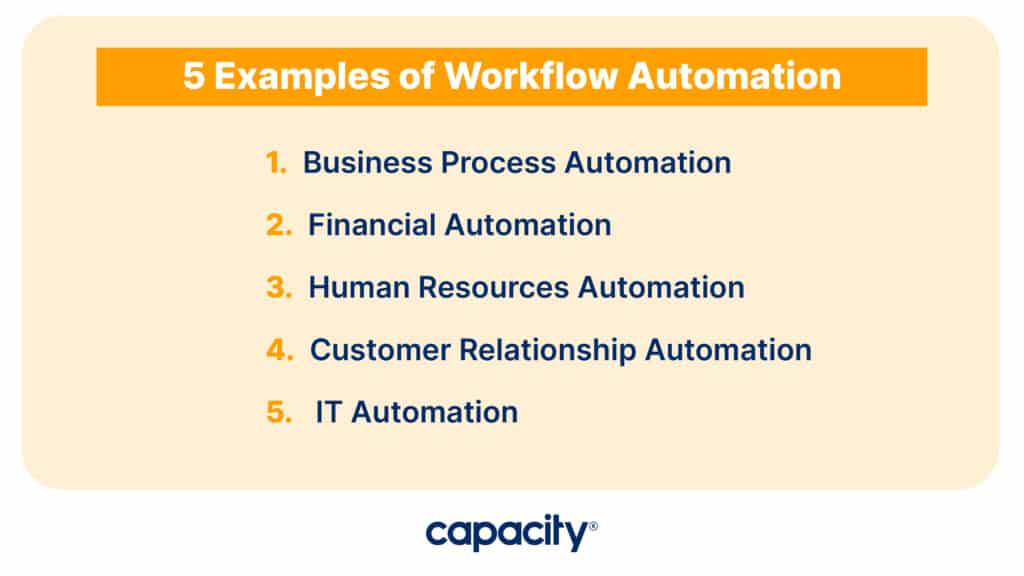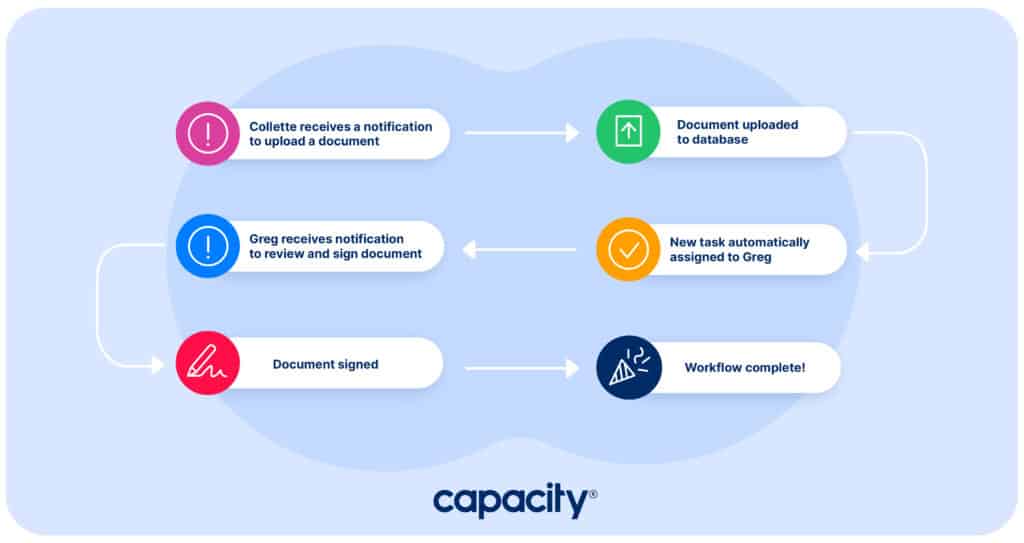What is workflow automation?
In 2023, workflow automation has evolved to include using AI and automation to complete tasks as part of the larger workflow. Automating workflows can help businesses save time and money and speed up the workflow to reduce errors and frustrations while increasing output. For example, workflow automation could route around an employee who might be out sick and deflect that part of the workflow to someone else with the same expertise, all without having to interrupt both the workflow and the employee who took time off. Workflows can be automated across the whole company, from activities that involve customers to highly complex business processes across every industry (Finance, Insurance, SaaS, and Education, to name a few).
How can workflow automation help businesses?
Workflows have always been around in business. You know them. You’ve seen them. They are usually big, hairy diagrams that can look like spiderwebs filled with dependencies, if thens, and lots of subject matter experts. Workflow automation has the potential to revolutionize businesses in many ways. By automating workflows, businesses can become more productive, save money on labor costs, and give time back to their employees by taking over mundane tasks. Many workflow automation solutions are also scalable, meaning businesses shouldn’t have to invest in new hardware or software to add more workflow automation capabilities once a business invests in a workflow automation solution.

5 examples of workflow automation
1. Business Process Automation workflow: Business process automation workflow involves automating the entire workflow that encompasses customer activity, marketing, sales, and finance. The primary benefit of workflow automation is reducing costs while allowing businesses to scale quickly. Automation workflow can also help reduce errors by having all tasks follow a standardized process.
2. Financial Automation workflows: As the name suggests, financial automation workflow focuses on automating financial processes such as accounts payable and receivable, budgeting and forecasting, data entry, invoicing, reporting, and analytics. Automating these processes helps free up time for more critical tasks like analyzing data or developing strategies.
3. Human Resources Automation workflows: Automating workflows means creating a system where tasks are completed without someone needing to do them manually. This can save businesses time and money, especially for Human Resources tasks like recruitment, onboarding, payroll, employee benefits administration, and training. Automating also helps ensure everyone is up-to-date on the latest rules or policies.
4. Customer Relationship Automation workflows: Automating your helpdesk’s workflow can help reduce response times by quickly and efficiently routing inquiries to the right people. Automation can also reduce the time spent on repetitive inquiries by providing automated responses. Helpdesk automation can also enable employees to focus on more crucial inquiries.
5. IT Automation workflows: Automating workflow in the IT department ensures workflow consistency and accuracy and improves customer service by reducing response times. Automation workflow also makes it easier for employees to access data, making them more productive and efficient.
Utilizing workflow automation doesn’t just bring financial rewards; it also creates more time for your personnel to be innovative and productive. Examples of these automated processes can streamline businesses by cutting out repetitive tasks so employees can concentrate on higher-level activities like strategy development or data analysis. Even better, the technology has become easily scalable: invest in a process once, then you’re ready whenever additional workflow capabilities are needed.
What are the different types of workflow automation?
Workflow automation comes in many forms, but the two main types are RPA (robotic) and Business Process automation. Let’s take a deeper dive into each one.

Robotic Process Automation (RPA) workflows
RPA workflow automation eliminates or reduces manual processes and repetitive tasks, like processing data or moving files. This type of workflow automation is designed to mimic a human’s physical actions, such as logging into an application or collecting data from multiple sources. Think of RPA as a digital robot that automates manual business workflow processes.
Business Process Automation workflow
Business Process Automation (BPA) workflow automation involves automating the entire workflow encompassing customer activity, marketing, sales, and finance. This type of workflow automation can automate complex workflows with multiple steps, including data entry and retrieval from various sources. With automated workflow, businesses can reduce costs while quickly scaling operations and reducing errors by following standardized processes.
Which is better: RPA or Business Process Automation? The short answer is that you’d need them both. Depending on the workflow, either type of workflow automation could be the perfect fit for your business. The key is understanding all available workflow automation tools and matching them with your specific needs and goals.

8 Steps to automate a workflow process
You can take a few steps to automate workflow processes in your organization. Here are 8 small steps you can take to automate workflows in your organization:
1. Identify workflow processes that can be automated. Start by understanding what workflow automation would benefit your business, like RPA or BPA workflow automation. Once you know what could be automated, create a list and prioritize each process to get started.
2. Analyze workflow processes for automation opportunities. Take a closer look at the workflow processes you have identified and map out the steps involved. This will help you better understand where workflow automation could ease the burden on your team and improve efficiency across all departments.
3. Select workflow automation software/tools that best fit your needs and goals. Look for workflow automation tools that are easy to use and provide features such as scalability and workflow improvement.
4. Develop a timeline for workflow automation. Set realistic deadlines for workflow automation projects and schedule regular check-ins to ensure you are on track with your workflow automation goals.
5. Develop workflow automation procedures, policies, and documentation. To ensure smooth workflow automation, create specific procedures for each type of workflow process and provide comprehensive documentation to all employees using the automated workflows.
6. Train personnel in new workflow systems/tools. Before any workflow automation is implemented, it’s essential to provide thorough training on how the new system works and how it should be used to achieve maximum efficiency.
7. Monitor workflow processes after they’ve been automated. To ensure workflow processes are correctly automated and working as intended, monitor workflow processes before, during, and after automation.
8. Make adjustments when needed. Automated workflow processes can be complex and require regular maintenance to work effectively. Adjust the workflow process or workflow automation tools to improve efficiency and performance over time if necessary.
Automating workflow processes means your organization will save time and money. Employees will have more time to do their work. Plus, the right automation system will make everything run more smoothly!
What are examples of workflow processes?
Workflow processes can vary depending on the type of workflow. Generally, workflow processes involve steps that must be completed to achieve a desired outcome, such as customer onboarding, purchase order approval, product delivery, invoice processing, or employee onboarding. Examples of workflow automation software/tools include Capacity, Zapier, and Workbot for RPA workflow automation and Pega for BPA workflow automation.

Here are 4 workflow processes that you can think about for your business:
Customer onboarding workflow -To ensure a smooth customer experience, this process involves quickly and thoroughly collecting customer information, verifying their identity, and processing payments securely.
Purchase order approval workflow – This process helps ensure that purchase orders are approved rapidly and accurately while maintaining a complete record of the financial details of each purchase.
Product delivery workflow involves selecting the right products for customers, monitoring stock levels, and preparing orders to be shipped and delivered.
Employee onboarding workflow entails attaining significant staff data, allocating tasks or resources for fresh employees, organizing onboarding sessions, and delivering ongoing assistance during their employment period.
Workflow Automation: Unlock Productivity, Save Money, and Give Time Back to Employees
Workflow automation tools can help businesses become more productive, save money, and give employees extra time to focus on critical tasks. To ensure workflow processes are adequately automated and work as intended, business owners should select workflow automation software/tools that best fit their needs and goals, develop a timeline for workflow automation, develop workflow procedures and policies, train personnel in new workflow systems/tools and monitor workflow processes after they’ve been automated. Automating workflow processes means organizations will save time and money while unlocking productivity.
Are you looking to build your first automated workflow? Take Capacity for a test drive for free, or request a demo.





